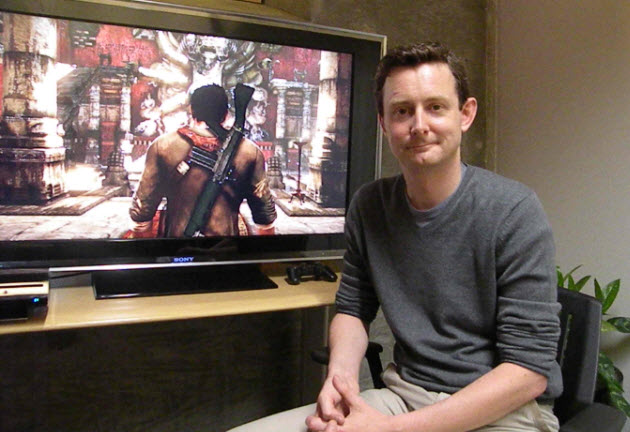 Uncharted 2: Among Thieves is one of the most anticipated games of the fall season. It is a Tomb Raider-like action adventure game reminiscent of a summer blockbuster movie, with a wisecracking hero Nathan Drake — nicknamed Dude Raider by wisecracking game critics.
Uncharted 2: Among Thieves is one of the most anticipated games of the fall season. It is a Tomb Raider-like action adventure game reminiscent of a summer blockbuster movie, with a wisecracking hero Nathan Drake — nicknamed Dude Raider by wisecracking game critics.
The original game from 2006, Uncharted: Drake’s Fortune, was one of the bestsellers on the console, but developer Naughty Dog stepped up with a huge investment — revamping the game’s 3-D graphics engine to make the new version even more gorgeous and riveting than the first.
The PlayStation 3 game hits store shelves on Oct. 13 in North America. The timing is good as the fall video game season gets underway. On top of that, Sony has just trimmed $100 off the price of its PlayStation 3 and introduced the new PS 3 Slim as well. We interviewed Richard Lemarchand, co-lead designer of the game. Be sure to catch the bonus video at the end, where Lemarchand tries to play and talk at the same time.
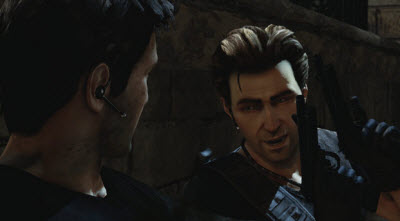 VB: What did you try to accomplish with Uncharted 2?
VB: What did you try to accomplish with Uncharted 2?
RL: We took new directions in our approach to storytelling. It led us to take an approach that was different from what most games take. As a character, Nathan Drake is quite different from other video game characters. He is recognizable as a regular guy. That was important for us. We wanted him to be a fallible hero — that was common as a thread in all of the pulp fiction we looked at. Our research for the original Uncharted took us all the way back to the beginnings of adventure storytelling. We looked at Robert Louis Stevenson and Robinson Crusoe. We zeroed in on early 20th century stories like Doc Savage, who was a finely honed physical specimen. That led us to heroes like Tintin. There you get more color in the characters, and more globetrotting in the stories. We looked at John Mclane from Die Hard. They’re not highly physically trained, but more regular guys who fight in a sloppy way. They don’t have precise Ninja powers.
VB: So you don’t like the direct comparisons of Nathan Drake as a male version of Lara Croft from Tomb Raider?
RL: We did get the Dude Raider thing a lot. We were always happy we were going in this completely different direction. Lara is in the vein of the perfect spy with precise athletic abilities. Nathan was always at right angles to that. That’s why he is a recognizable character. It’s very humanizing. He throws a punch in a way that will put him off balance and let him get clunked on the head. This fed into the animation technologies for the game. When a character’s moves are more human, then you have to do more work to introduce irregularity and variation into the way he is animated. In fact, in some sense, his movements are procedural. That is, the individual movements are not scripted, but they are put together as needed. Each movement is really made up of hundreds of discrete animations that we blend together on the fly so you never see him stumble in the same way twice — or at least you never notice it. You notice that in his gait as he moves down a street.
 VB: Does that mean you did motion capture with an actor in a studio for every possible kind of movement?
VB: Does that mean you did motion capture with an actor in a studio for every possible kind of movement?
RL: We used every animation technique you can imagine. We do start with motion capture, both from the actors who portray the characters and some stunt people. Then it is heavily hand animated on top of that. Many of our artists have a traditional animation background. We didn’t go for straight photo reality. We wanted to go with a stylized hyper reality in keeping with our pulp fiction roots. We wanted everything to be just a little larger than life. That comes through in the colors, in the eccentric characters and humor. It’s also comes through in the way that Nate’s animations squash and stretch in the same way that traditional animation does. The animators would use the motion capture as a base and then exaggerate things in subtle ways to build the animations we use in the game. On top of that, we combine the animation algorithmically on the fly. You may see a dozen animations at once with our proprietary animation engine. This is the way we make him responsive and controllable. He will be running along and stumble. He will be getting back up as you press the button to reload his gun. He will immediately pop the magazine out because we will have a different animation on the top part of his body compared to the bottom part of his body. He will duck away from bullets when there is gunfire going off around his head. Each time he goes into cover, he will assume a different pose. You get hundreds of animations as a result.
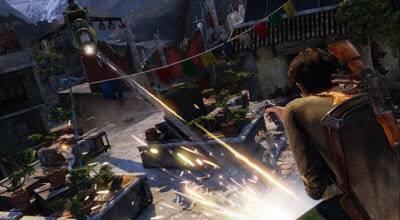 VB: When did you start on this?
VB: When did you start on this?
RL: Pretty much the day that the first Uncharted shipped, a little shy of two years.
VB: And what benefit did you get from having done the first one. Did you get to reuse your graphics engine?
RL: In one sense, we had a tremendous leg up. Everyone understood what kind of game we were making. We started in the way we couldn’t before, hitting the ground running on the game design. But in the course of development of the second game, we rebuilt our engine. Now it is called the Naughty Dog engine 2.0. We took things out and replaced them and so it was almost brand new. That means we can do so much more in the game now.
VB: A lot of game teams reuse their engines entirely from the previous games because they want to amortize the costs of the engine over more than one game. Did you?
RL: We didn’t amortize the engine. We are quite famous for taking on a challenge. We caused a bit of a stir when we said that in the first Uncharted, we used only 30 percent of the Cell processor in the PlayStation 3. Now we are closer to using much of it. We used the processing power in all manner of new systems. We created a system where the character could interact with moving objects in the environment. Normally, a game character interacts with static objects. We decided at the beginning, in the service of one idea for a level that had to do with a moving train, to allow Nathan Drake to interact with any moving objects, so that he could use his moves on anything. I’m sure you’ve seen games where a train is static and the scenery is scrolling by. We wanted a big level, where you could traverse train cars, and to have a scene where the train was moving and there were objects moving with it. The train environment is live. You can clamber on top of the train cars, drop down inside them and take cover. You can hang off the edges of it. You can use the train car itself as cover. Bits are breakable, like a skylight you can shoot out. You can do anything you can do with a static background on one of these train cars. To our knowledge that hasn’t been done before.
VB: How does that tie back to the hardware? It has to do with the raw calculation of collisions between objects. When one thing is moving and another thing is static, it’s an easier set of equations to solve in terms of what happens when they bump into each other. These objects have animations that are dependent on them. This work paid off. It was one of the first things we started on and one of the last things we finished. This traversal on dynamic objects shows in every level of the game. We showed this at E3, with our demo of the war-torn Nepalese city where a helicopter is chasing Nathan Drake and shoots out pieces of the building. The building’s floor collapses and all of the desks move around. That was this technology in action.
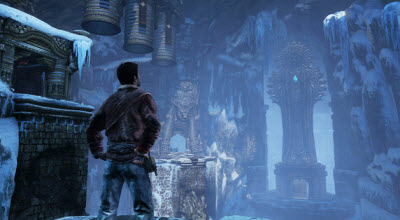 VB: People have been talking about physics in-game for a while. It looks like you have found ways to improve the quality of physics beyond what others have done?
VB: People have been talking about physics in-game for a while. It looks like you have found ways to improve the quality of physics beyond what others have done?
RL: Yes. There are different qualities to the level of physics. This is a huge effort for us. We are doing a lot more physics and dynamic stuff in this game. It’s lots of hand-coding of breakable objects in the environment. We are very lucky in that we have a tools group on site at Naughty Dog that makes third party tools for every Sony developer. We have a rich dialogue with them, but we mainly write most of our own programming.
VB: How many people did you use on this game?
RL: We have more people. I’m still reeling from the production so I’m not sure how many. We have about 100 people in-house. We did scale up a little bit by using excellent contractors who came in as we got to the end of the project. But the team was not that much bigger. It’s a testament to how hard the team worked. It’s critically important to work as a team. You can achieve so much more than people who are pulling in different directions. We don’t have anyone who has the title of producer. We definitely have people who are de facto producers, but the team is really self-producing. Our presidents of the company, Evan Wells and Christophe Balestra, are very hands-on. Christophe started in the demo scene in France doing graphics code. Their involvement sets the pattern for us to organize ourselves.
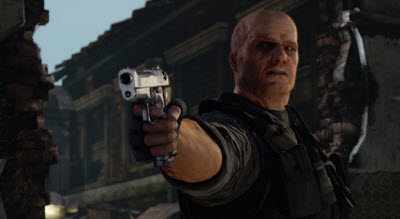 VB: If you are developing something for two years, how do you set a high enough target?
VB: If you are developing something for two years, how do you set a high enough target?
RL: We do it in a number of ways. We are very self critical. We are big fans of games and visual effects. We always want to push each other and ourselves to hit higher achievements. We are also setting high goals for ourselves doing early concept work. For Uncharted: Drake’s Fortune, we made an early target render, rendered in engine but not yet fully playable. That really helped us to set a graphical benchmark for ourselves and understand how the gameplay was going to work. It’s very true a picture paints a thousand words and 30 pictures a second paints even more words. The development team can understand and then rally around it. Those are our two main techniques. We did more visualization with concept art on this project.
VB: How do you deal with the common complaint that game costs are out of control? A lot of companies make great games, but their bottom lines suggest that their costs are going way up.
RL: We are a small team and that helps. When you make something that is of high quality, there is automatically a greater market for it. We are motivated by a desire to make something really fantastic, something that we love. It might be idealistic of me, in my personal opinion, but in the arts, I think that translates into sales.
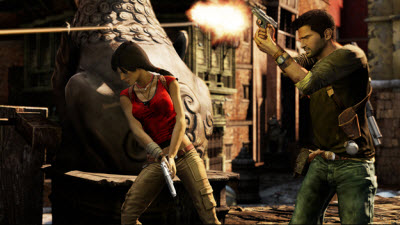 VB: Do you take into account changing gamer tastes?
VB: Do you take into account changing gamer tastes?
RL: I don’t think we took a radically different approach with the second game. With Uncharted: Drake’s Fortune, we felt we had grown up and our audience had grown up with us. We went from Crash Bandicoot to Jak & Daxter to Nathan Drake. There is a evolution. We wanted to keep giving gamers what they wanted from a video game: compelling play dynamics. All of our games are easy to pick up and start playing, but then they yield richness and depth. We knew we wanted to keep doing that. We wanted to keep exceeding expectations as far as game play went. Perhaps the most important shift is tone. We wanted to tell a story that had more emotional depth and nuance and resonance. That’s what people are picking up on in the series. As much as Drake’s Fortune thrust Nathan and Elena, his partner in adventure, into a special situation on an island where Nathan was forced to be a hero from the start. We set out with Uncharted 2 to put him more in his element of international treasure hunting. These are people with one foot in the legitimate world and another foot in the much dodgier world of international art theft. We feel we have achieved it. You will see Nathan isn’t drawn quite straightforward as a hero. He is surrounded with ethically challenged people. That draws out those elements in him and holds up a mirror to him. We can see him as a real person and that raises the stakes of the real adventure. It puts the good people around him in greater peril. We felt the video game audience was ready for a whole lot more than the same standards they get from the other media they enjoy.
VB: At E3, you got a great reception. It stood out. What makes it better?
RL: The graphics are eye catching initially. There are two or three things that really stand out for people. You can tell it is a character-driven story and not a plot-driven story from the first couple of quips in the scene where Nathan wisecracks about how we usually have to climb things. You have characters you have to empathize with. It also was an active cinematic experience. When we showed this helicopter level, you could see we were actively playing through this level. In the past, these scenes might have been canned, where we show you a movie of something happening but you can’t play it. You now have a scene that is completely playable. You don’t lose control as Nathan moves around the floor of this collapsing building. We only take control away very briefly, as in the middle of an explosion, and the player doesn’t notice. Things happen around you as we knock Nathan on his ass and put him in one life-threatening situation after another. That’s a compelling experience and the promise of video games.
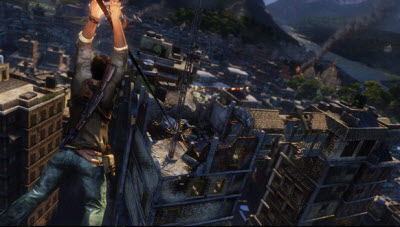 VB: As you kept your head down making this game, the video game industry changed. There are free-to-play games and social games. There is almost a siren call for developers to leave the big game companies and join these small startups. How do you keep your people focused so you can get the multi-year project done?
VB: As you kept your head down making this game, the video game industry changed. There are free-to-play games and social games. There is almost a siren call for developers to leave the big game companies and join these small startups. How do you keep your people focused so you can get the multi-year project done?
RL: The kind of game that we make is clearly different. Everyone at Naughty Dog feels the console business is still very viable as a business model going forward. A big part of our sustained belief in that has to do with our multipalyer game. We have done only one multiplayer game before, Jak X, which was quite a few years ago. The way that the multiplayer has come together has surprised even some people at the studio. We took the core move set of Nathan Drake, gave the player the ability to wear the bodies of the characters in the game, plopped them down in block-mesh models, you would climb around and shoot your buddies. It was immediately so compelling we knew we had a winner. It was compelling because Nathan Drake’s mechanics were so on the button. You can jump across that gap. That’s what you need in a great action game. Once we solved technical issues around latency, and keeping the players synchronized, we were off and running. To get back to the point: that is a big part of what makes Uncharted 2 the best value for entertainment this holiday season. You get 10 to 12 hours of single-player game and possibly hundreds of hours of multiplayer gameplay.
VentureBeat's mission is to be a digital town square for technical decision-makers to gain knowledge about transformative enterprise technology and transact. Learn More
